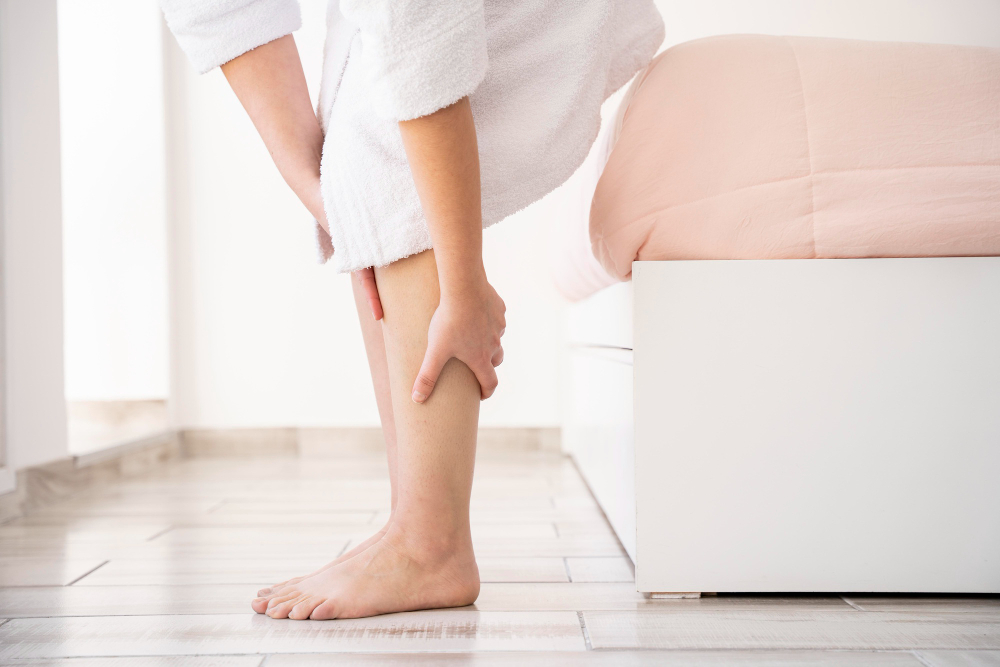Picture this: you’re nestled under the covers, ready to embrace the embrace of sleep, when suddenly, a wave of discomfort sweeps over your legs. The ache is accurate, and it’s happening just when you should be drifting into a peaceful slumber. What’s behind these nocturnal leg aches that seem to defy the logic of timing? In this exploration, we delve into the leg discomfort that strikes when the moon is high, uncovering the mysteries and potential causes of why your legs ache at night.
Understanding Nocturnal Leg Aches
Nocturnal leg aches, restless legs syndrome (RLS), or nighttime leg cramps can manifest as various sensations. Some individuals describe it as an itching or crawling feeling deep within the legs, while others feel an irresistible urge to move their legs. For some, it’s the sensation of cramping, tightness, or pain. Regardless of the exact sense, one thing is clear: It’s a sensation that’s hard to ignore, especially when all you want is a good night’s sleep.
Restless Legs Syndrome Unveiled
Restless legs syndrome (RLS) is a neurological disorder characterized by uncomfortable sensations in the legs, often accompanied by an uncontrollable urge to move them. These sensations worsen during rest or inactivity, such as when sleeping. RLS can disrupt sleep and lead to daytime fatigue, affecting the quality of your slumber and overall well-being.
Unraveling the Neurotransmitter’s Role
Researchers believe that RLS is linked to an imbalance in the brain’s dopamine system. Dopamine is a neurotransmitter that is crucial in regulating movement and mood. When there’s a disruption in dopamine levels or receptor sensitivity, it can lead to the sensation of restless legs. This is why medications that affect dopamine activity are often used to manage RLS symptoms.
Why It Strikes at Night
Your body operates on a circadian rhythm, an internal clock that regulates sleep-wake cycles and various physiological processes. For individuals with RLS, the circadian rhythm appears to play a role in exacerbating symptoms at night. As the day winds down and you settle into rest, the combination of reduced physical activity and the circadian dip in dopamine levels can trigger the uncomfortable sensations associated with RLS.
The Role of Iron Deficiency
Iron deficiency is another factor that can contribute to nocturnal leg discomfort. Iron plays a role in dopamine production; low iron levels can disrupt dopamine activity. Individuals with iron deficiency anemia are more prone to RLS symptoms, as the lack of iron affects the brain’s ability to regulate dopamine properly. If you’re experiencing nighttime leg aches, consider your iron levels.
Lifestyle and Habits That Aggravate Symptoms
Certain lifestyle factors and habits can worsen nocturnal leg aches. Caffeine and alcohol consumption, especially in the evening, can disrupt sleep and exacerbate RLS symptoms. Similarly, smoking has been linked to increased RLS risk. Lack of physical activity or prolonged sitting can also trigger discomfort. You can minimize nighttime leg aches by identifying and addressing these lifestyle factors.
Underlying Health Issues to Consider
Nocturnal leg aches can also be a symptom of underlying medical conditions. Peripheral artery disease, which involves reduced blood flow to the legs, can cause pain and cramping, especially at night. Diabetes, nerve damage, and certain medications can also contribute to leg discomfort. If your symptoms are persistent or accompanied by other health concerns, it’s essential to consult a healthcare professional for a thorough evaluation.
A Common Experience
Pregnant women often experience nocturnal leg discomfort, particularly in the later stages of pregnancy. The exact cause is not fully understood, but hormonal changes, increased blood volume, and pressure on blood vessels and nerves can contribute to leg cramps and sensations of discomfort. Staying hydrated, maintaining a balanced diet, and gentle stretching can help alleviate symptoms during pregnancy.
Strategies to Soothe Nocturnal Leg Aches
If you’re tired of tossing and turning due to nocturnal leg aches, there are several strategies you can try to find relief:
- Regular Exercise: Regular physical activity can improve circulation and reduce RLS symptoms. Aim for a mix of cardiovascular exercise and stretching.
- Massage and Stretching: Gentle leg massages and targeted stretches, especially before bedtime, can help relax muscles and alleviate discomfort.
- Warm Baths: Soaking your legs in a warm bath before bed can promote relaxation and ease muscle tension.
- Medications: In cases of severe RLS, your doctor might recommend medications that help regulate dopamine levels or address iron deficiencies.
- Healthy Lifestyle: Maintain a balanced diet, stay hydrated, limit caffeine and alcohol intake, and avoid smoking to reduce triggers for RLS symptoms.
- Mindful Rest: Engage in relaxation techniques before bedtime, such as meditation, deep breathing, or yoga, to help calm your nervous system.
Navigating the Nighttime Puzzle
The sensation of nocturnal leg aches is a nighttime puzzle woven with threads of neurological, physiological, and lifestyle factors. While restless legs syndrome can make sleep feel elusive, understanding the connections between dopamine, iron, and the circadian rhythm can help shed light on why these sensations occur when the world around you is in deep slumber. By adopting a holistic approach that includes lifestyle adjustments, targeted exercises, and potential medical interventions, you can work towards unraveling the mystery of why your legs ache at night and reclaim the peaceful rest you deserve.
